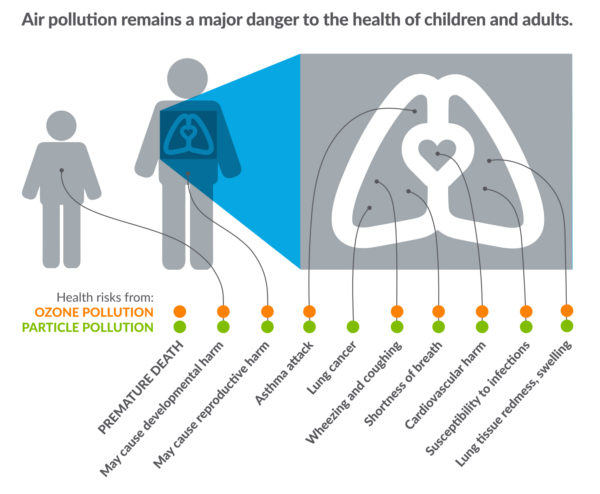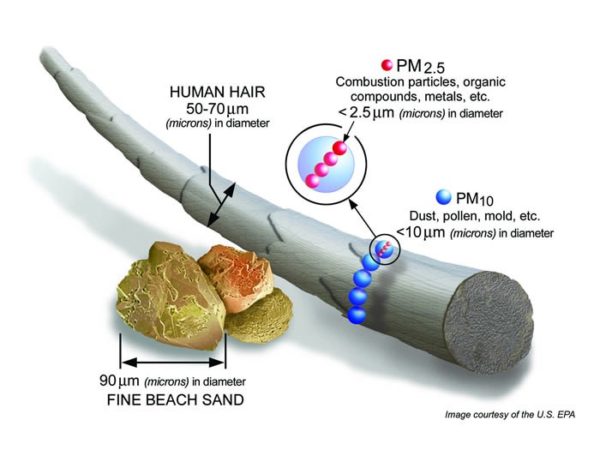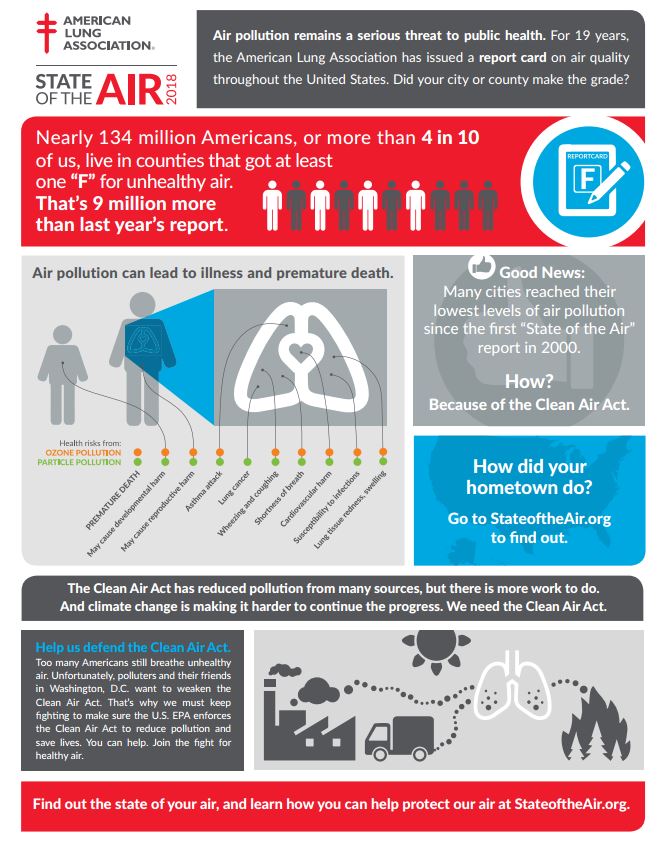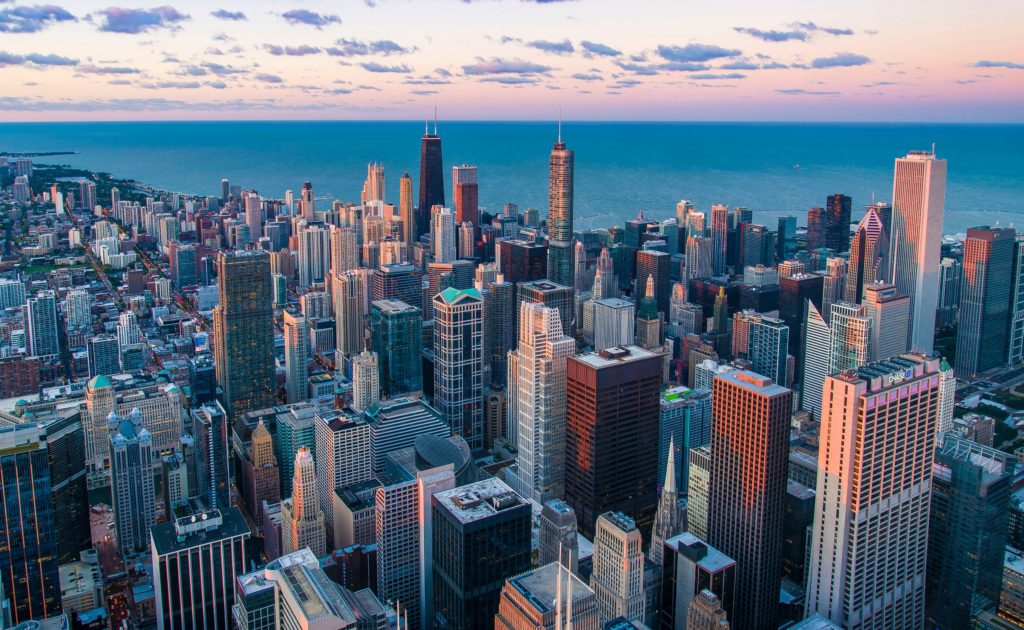With updated city rankings, ozone and particle pollution reports, and so much more, the ALA releases its annual 2018 State of the Air Report.
Each year, the American Lung Association releases their State of the Air report which covers findings and research on a variety of air quality topics. These topics include a general overview of the state of the air of the nation, the health effects of ozone and particle pollution, as well as detailed city rankings for air quality. To reference previous reports, check out 2017’s State of the Air summary we wrote about.
The report overview states:
The “State of the Air 2018” found ozone pollution worsened significantly in 2014-
2016 compared to the previous report, while improvements continued in year-round
particle pollution and fewer episodes of high particle days. This year’s report provides
continued evidence that the United States must continue to fight climate change and to
support and enforce the Clean Air Act to protect the nation from unhealthy air.
The State of the Air 2018 report shows that many cities across the nation experienced
more days when ground-level ozone, also known as “smog,” reached unhealthy levels,
including most of the cities with the worst ozone problems.The “State of the Air 2018” report adds to the evidence that a changing climate is
making it harder to protect human health. With record-setting heat in 2016, high
ozone days zoomed, putting millions more people at risk and adding challenges to the
work cities are doing across the nation to clean up.The Clean Air Act must remain intact and enforced to enable the nation to continue to
protect all Americans from the dangers of air pollution. This law has driven improvements in
air quality for 48 years, improvements that the State of the Air 2018 continues to document.
The nation must ensure that the Clean Air Act’s tools remain in place, funded and followed.
The “State of the Air 2018” report looks at levels of ozone and particle pollution found
in official monitoring sites across the United States in 2014, 2015 and 2016. The report
uses the most current quality-assured nationwide data available for these analyses.The report examines particle pollution (PM2.5) in two separate ways: averaged yearround
(annual average) and over short-term levels (24-hour). For both ozone and
short-term particle pollution, the analysis uses a weighted-average number of days
that allows recognition of places with higher levels of pollution. For the year-round
particle pollution rankings, the report uses averages calculated and reported by the U.S.
Environmental Protection Agency (EPA). For comparison, the “State of the Air 2017”
report covered data from 2013, 2014 and 2015.
From there, the report goes on to address the in-depth findings for each of the following topics:
- Ozone Pollution
- Year-Round Particle Pollution
- Short-Term Particle Pollution
- Cleanest Cities/Most Polluted Cities
- People/Populations at Risk
- 6 Threats to Nations Air Quality
- Weakening the Clean Air Act
- Repealing plans to reduce carbon pollution from power plants
- Removing limits on emissions from oil and gas operations
- Opening doors for more polluting trucks and cars
- Cutting funding and expertise needed to clean up the air
- Stacking the deck to deny the scientific evidence
- What you can do to fight for healthy air
Understanding Ozone and Particle Pollution

The report references ozone and particle pollution quite a bit. Simply defined, ozone pollution is often what we consider to be smog. It is a gas molecule composed of 3 oxygen atoms and is harmful to breathe. Ozone found in the upper atmosphere shields us from the sun’s harmful ultraviolet rays, but at ground level, it is much more dangerous to breathe in. Most ozone at ground level develops from gases of vehicle exhaust, smokestacks, power plants, and many other sources. When these gases come into contact with sunlight, ozone smog forms.
Ozone impacts your health in a variety of ways. It can significantly shorten your life, cause immediate breathing problems like asthma and shortness of breath, cardiovascular effects like heart disease, and even decreased lung function in newborns.
Based on the research from the State of the Air report, warming global temperatures were a significant factor in high ozone levels:
The “State of the Air 2018” found ozone pollution significantly worsened in 2014-2016, while improvements continued in year-round particle pollution and fewer episodes of high particle days. The number of people exposed to unhealthy levels of air pollution increased to more than 133.9 million people, higher than the 125 million in the years covered by the 2017 report (2013-2015).
The spike in ozone demonstrates the public health impact of increased temperatures from the changing climate on the nation’s air quality. With 2016 marking the second warmest year on record, the higher temperatures provided fuel to increase the formation of ozone from the still under-controlled emissions of the precursor emissions.
Particle pollution is different from ozone pollution in that particle pollution includes tiny, but still dangerous, particulate matter composed of solid or liquid particles that are harmful when absorbed by the lungs.

As you can see from the graphic above, PM 2.5 is incredibly small in size and therefore has an easier time infiltrating our body. Breathing particle pollution can cause problems like respiratory illnesses, hospitalization, and even premature death. Particle pollution decreases lung function and can be extremely dangerous to sensitive groups like the elderly, people with chronic respiratory issues, and especially children.
The State of the Air report delves deep into particle pollution levels around the nation and the various effects of year-round and short-term exposure.
While most of the concerns regarding ozone and particle pollution remain outdoors, it is important to protect yourself from indoor air pollutants as well. With these rising concerns regarding air quality, a powerful air purifier has never been more essential. The LP60 air purifier features dual filter technology with VENTAcel Nelior Filters. These advanced filters have a 99.95% filtration efficiency down to 0.07 microns. This performance is unsurpassed by all other HEPA filters currently available on the market. Learn more about the unparalleled features and performance of the LP60 in our in-depth blog post.
City Rankings
Each State of the Air report features updated city rankings, which measure a metropolitan area’s ozone and particle pollution.
Top 5 cleanest cities for year-round particle pollution:
- Cheyenne, WY
- Honolulu, HI
- Casper, WY
Top 5 most polluted cities for year-round particle pollution:
- Fairbanks, AK
- Visalia-Porterville-Hanford, CA
- Bakersfield, CA
Top 5 most polluted cities for ozone:
- Los Angeles, CA
- Bakersfield, CA
- Visalia-Porterville-Hanford, CA
Each state has its own report as well, which can be viewed here: State Air Quality Report Card
As air quality advocates, the Venta USA team is grateful for the extensive research and work that goes into the State of the Air report each year. The findings are helpful in understanding our nation’s air quality and how we can continue to work towards healthier air for all.


